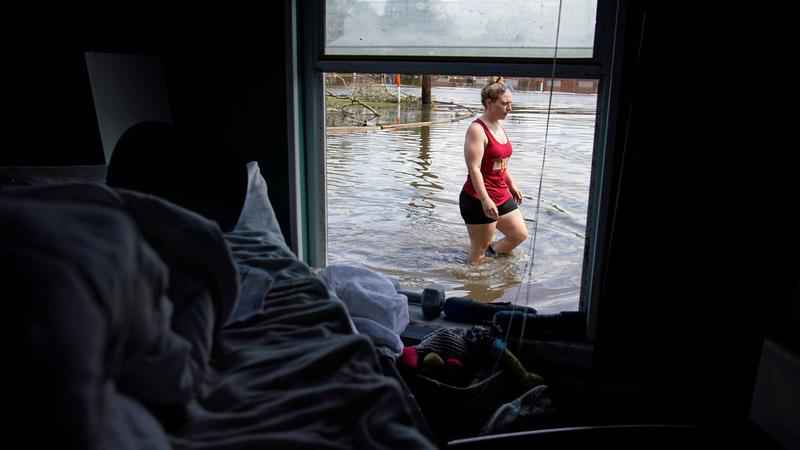Hurricane Ida’s aftermath, recovery uneven across Louisiana

Emily Francois walks through flood waters beside her flood damaged home in the aftermath of Hurricane Ida, Wednesday, Sept. 1, 2021, in Jean Lafitte, La. Louisiana residents still reeling from flooding and damage caused by Hurricane Ida scrambled Wednesday for food, gas, water and relief from the sweltering heat as thousands of line workers toiled to restore electricity and officials vowed to set up more sites where people could get free meals and cool off.[AP Photo/John Locher]
In New Orleans, an ongoing power outage after Hurricane Ida is making the sweltering summer unbearable. But in some areas outside the city, that misery is compounded by a lack of water, flooded neighborhoods and severely damaged homes.
Four days after Hurricane Ida struck, the storm’s aftermath — and progress in recovering from it — are being felt unevenly across affected communities in Louisiana. The levee system revamped after Katrina protected New Orleans from catastrophic flooding after Ida struck on Sunday with 150 mph (230 kph) winds, tied for the fifth-strongest hurricane to ever hit the mainland U.S.
The power was back on before dawn Thursday in the city’s central business district, Uptown, Midtown, New Orleans East and the Carrollton area, the electricity company Entergy announced. Utility crews also restored power to Ochsner’s main hospital campus in Jefferson Parish and several hospitals near Baton Rouge. City crews completely cleared some New Orleans streets of fallen trees and debris, and a few corner stores reopened.
Outside New Orleans, neighborhoods remained flooded and residents were still reeling from damage to their homes and property. More than 1,200 people were walking through some of Ida’s hardest-hit communities to look for those needing help, according to the Louisiana Fire Marshal’s office. President Joe Biden was scheduled to visit Louisiana on Friday to survey the damage, the White House said.
Gayle Lawrence lost two cars, refrigerators and almost everything in her garage to floodwaters in southern Louisiana’s Plaquemines Parish. The garage was filled with marsh grass and dead fish. Scores of other homes in the neighborhood were also flooded.
"The house is solid. It didn’t even move. But when the water came up, it destroyed everything," she said.
In Jefferson Parish, authorities on Wednesday were still waiting for floodwaters to recede enough for trucks carrying food, water and repair supplies to begin moving into Lafitte and other low-lying communities. The parish neighbors New Orleans and saw widespread destruction from Ida.
Parish President Cynthia Lee Sheng said a gas shortage was hampering hospital staff, food bank employees and other critical workers.
"Today, we’re a broken community," Sheng told a news conference. "It won’t always be that way."
Evacuees considering returning home to Terrebonne Parish were warned by emergency officials on Twitter that "there are no shelters, no electricity, very limited resources for food, gasoline and supplies and absolutely no medical services."
Louisiana Gov. John Bel Edwards said he’s pleased that power returned for some people. It’s "critically important to show progress" after the storm, he said, while acknowledging that much more work lies ahead. Roughly 2,600 people remain in shelters, he said.
"I’m very mindful that it’s a start, and only a start," he told a news conference.
As the staggering scope of the disaster began to come into focus, with a private firm estimating that total damage from Ida could exceed $50 billion, making it among the costliest U.S. hurricanes.
The death toll rose to at least 14, with eight more deaths reported in New York City on Thursday morning as Ida’s remnants unleashed floods across the northeastern U.S. Earlier deaths included a 65-year-old woman who drowned in her Louisiana home and a 19-year-old found dead in a Maryland apartment complex just north of the nation’s capital.
But about 989,000 homes and businesses — 44% of all state utility customers in southeast Louisiana, from the New Orleans area to Baton Rouge — were without power, according to the state Public Service Commission. In neighboring Mississippi, more than 30,000 customers had no electricity. More than 600,000 people were without water.
Hard-hit areas in southeast Louisiana were under a heat advisory Thursday, with forecasters warning combined heat and humidity could make some areas feel like 106 degrees Fahrenheit (41 degrees Celsius).
New Orleans officials opened seven places where people could get a meal and sit in air conditioning. The city was also using 70 transit buses as cooling sites, Mayor LaToya Cantrell said.
Karen Evans charged electronic devices at a New Orleans gym where four tall fans stirred the air. Her home in the city was not damaged, but she was struggling without power.
"The great challenge is living a life in a sweltering place without air conditioning," she said.